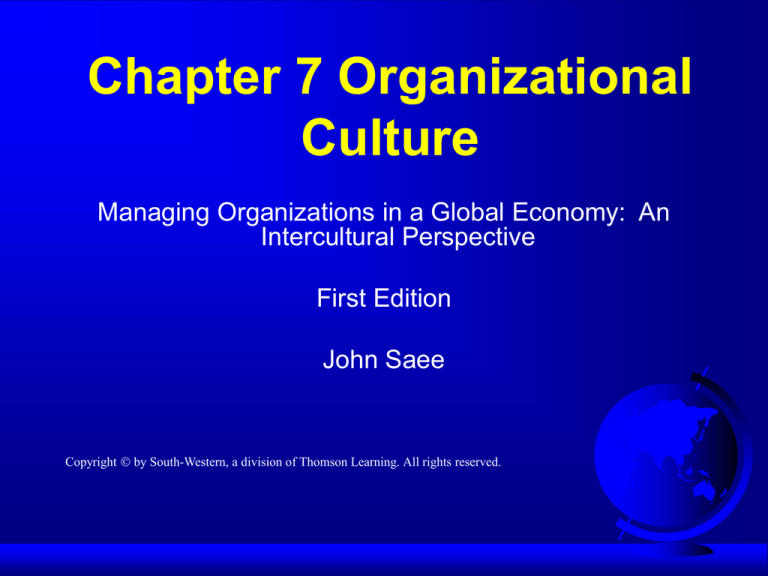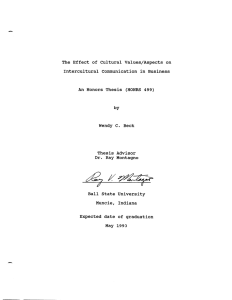
Chapter 7 Organizational
Culture
Managing Organizations in a Global Economy: An
Intercultural Perspective
First Edition
John Saee
Copyright by South-Western, a division of Thomson Learning. All rights reserved.
What is corporate culture?
Corporate culture is an ideology shared by
members in an organization (Ouchi 1981;
Pascale & Athos 1981; Deal & Kennedy
1982).
The sense making and control
mechanism that guides and shapes the
attitudes and behavior of employees
(Robbins, Millet, Cacioppe 1998).
Functions
of organizational culture
Organizational culture defines boundary.
Organizational culture conveys a sense
of identity for its members.
Organizational culture facilitates
commitment by its members.
Organizational culture provides standard
code of conduct.
Relationship between the culture and the
success of an organization.
Management is fast realizing that
organizational culture is the driving force
behind its successful operations.
Peters and Waterman (1984): “Without
exception, the dominance and coherence of
culture proved to be an essential quality of
the excellent companies” (p. 75).
Organizational Culture and
NationalCulture
Cultural preferences will influence the
models people give to the organizations.
Are organizational cultures as influential as
national cultures?
National values are always likely to
overrule contrasting organizational values.
Hofstede’s research has shown that
national culture values have significant
impact on employees’ organizational
performance, and the cultural values
employees bring with them to the
organization are not easily changed by the
organization.
Dimensions of organizational culture.
Cultural comparisons were made between
different subsidiaries of the same MNC
(Hofstede 1980). It was found that different
cultures existed in each subsidiary.
How far can a company go to
implement an organizational culture
across different national cultures?
An organization should seek to evolve
a culture, which complements the
national one but still manages to
maintain its own corporate identity
and individuality.
Organizational Cultures in MNCs
To determine the organizational culture
requires examination of three aspects
(Trompenaars 1993):
The general relationship between employees
and their organization.
The vertical or hierarchical system of
authority defining superiors and
subordinates.
Views of employees about organization’s
destiny, purpose, goals, and their place in it.
Trompenaars (1993) identified and described
four types of organizational cultures:
“family,” “Eiffel tower,” “guided missile,”
and “incubator.”
“Family”
Strong emphasis on the hierarchy and
orientation to the person.
“Eiffel
Tower”
Strong emphasis on hierarchy and orientation to
the task.
“Guided
Missile”
Strong emphasis on equality in the work place
and orientation to the task.
“Incubator”
Strong emphasis on equality and personal
orientation.
Organizational Cultures and
Country Preferences
Trompenaars
and Hampden-Turner
attempted to identify national patterns of
corporate culture. They surveyed 13,000
respondents across 42 countries.
The
author suggests that MNCs should
adjust their local organizational cultures to
fit the cultures of the countries where they
have operations.
Managing Multiculturalism and
Diversity
What
is workforce diversity?
Today, the workforce is comprised of people
who are different and who hold a wide range
of attitudes, needs, desires, values, and work
behaviors (Saee 1990, 1993; Rosen &
Lovelace 1991; Deluca & McDowell 1992;
Morrison 1992).
Perceptions
of the impact of cultural
diversity on organizations.
Ineffective management of cultural diversity
within most organizations stems from the
nature of corporate culture which is basically
mono-cultural and it does not value cultural
diversity (Karpin 1995).
Organization
may be parochial,
ethnocentric, or synergistic in its strategic
response to cultural diversity (Adler 1997).
Organization
may be defined in terms of its
organizational culture as monolithic or
pluralistic (Hellriegal, Jackson, Slocum
1999).
Disadvantages because of
cultural diversity:
Problems most frequently occur in
convergence situations when the
organization needs employees to think and
act in similar ways.
These problems may be:
Attitudinal
Perceptual
Communicational
Increased
anxiety among managers because
of a culturally diverse environment also
presents a problem (Irwin & More 1994).
Advantages because of
cultural diversity:
Employees from various cultural
backgrounds can assist organizations in
understanding cultural effects on buying
decisions, marketing decisions, and in
mapping strategies to respond to them.
Sales benefit if consumers have some
opportunities to interact with organizational
representatives of their own communities
(Saee 1998).
Enhanced creativity, flexibility, problem
solving, especially for complex problems
involving many qualitative factors (Hayles
1982).
Strategies for managing
cultural diversity
Cultural
diversity in the workforce can be a
source of strength for an organization,
provided the organization manages that
diversity effectively.
Cultural
dominance:
Doing the things the way they are done in your
own culture.
Accepting new ideas is facilitated (Adler
1997).
New perspectives, better communication,
and cooperation (Saee 1998).
Cultural
accommodation:
An attempt to imitate the practices of the host
culture, blending into it.
Cultural
compromise:
Both sides make concessions in order to work
more successfully with each other.
Cultural
avoidance:
Acting as if there are no differences and no
conflict exists.
Cultural Synergy:
Cultural
synergy involves a process in
which managers form organizational
strategies, policies, structures, and practices
based on, but not limited to, the cultural
patterns of individual organization members
and clients (Adler 1997).









